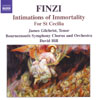Finzi Intimations of Immortality; For St Cecilia
Deeply felt music with a response to match make the Finzi choice so close
View record and artist detailsRecord and Artist Details
Composer or Director: Gerald (Raphael) Finzi
Genre:
Vocal
Label: Naxos
Magazine Review Date: 8/2006
Media Format: CD or Download
Media Runtime: 56
Mastering:
Stereo
DDD
Catalogue Number: 8 557863

Tracks:
| Composition | Artist Credit |
|---|---|
| Intimations of Immortality |
Gerald (Raphael) Finzi, Composer
Bournemouth Symphony Chorus Bournemouth Symphony Orchestra David Hill, Conductor Gerald (Raphael) Finzi, Composer James Gilchrist, Tenor |
| For St Cecilia |
Gerald (Raphael) Finzi, Composer
Bournemouth Symphony Chorus Bournemouth Symphony Orchestra David Hill, Conductor Gerald (Raphael) Finzi, Composer James Gilchrist, Tenor |
Author: John Steane
These are fine performances but the balancing of the tenor soloist is not entirely happy. The voice is closely recorded and emerges as too separate from the choir. Other versions of the Intimations manage it better, Philip Langridge being perhaps a shade too recessed under Hickox (EMI – nla), John Mark Ainsley just about right under Matthew Best (Hyperion, 1/97). All three give a sensitive account, my own preference lying with the Hyperion (clearest in texture and probably most thoughtful) but only marginally so. The tenors are much of the same school, all of them intelligent and musicianly in approach, Ainsley with the most even production, Langridge with the most personal touch but also with a sense of high notes reached only by effort and technical know-how, Gilchrist with more ease but a tendency to make that small crescendo on individual notes which is inimical to a true legato. The Bournemouth chorus sing cleanly but I find the others clearer and more expressive with their words. The orchestra sustain all comparisons and one feels David Hill’s direction to be both firm and inspiring.
The ode incorporates some of Finzi’s most deeply felt writing. It ‘integrates’ more fully with each hearing, yet I still can’t quite reconcile the more characteristic musical idiom with the Waltonian percussion and the rhythmic insistence of the third section. The poet himself imposes a co-existence of rejoicing and regret, of stark recognition and stoical resolution, though Finzi often seems more atuned to the misgivings.
In For St Cecilia, text (by Edmund Blunden) and music match perfectly, though Finzi is perhaps rather self-consciously wearing Elgarian garb in the opening, appearing as his unmistakable self in the lovely fourth section, ‘How smilingly the saint among her friends sits’. The two works couple well and are informatively introduced in a note by Andrew Burn.
The ode incorporates some of Finzi’s most deeply felt writing. It ‘integrates’ more fully with each hearing, yet I still can’t quite reconcile the more characteristic musical idiom with the Waltonian percussion and the rhythmic insistence of the third section. The poet himself imposes a co-existence of rejoicing and regret, of stark recognition and stoical resolution, though Finzi often seems more atuned to the misgivings.
In For St Cecilia, text (by Edmund Blunden) and music match perfectly, though Finzi is perhaps rather self-consciously wearing Elgarian garb in the opening, appearing as his unmistakable self in the lovely fourth section, ‘How smilingly the saint among her friends sits’. The two works couple well and are informatively introduced in a note by Andrew Burn.
Discover the world's largest classical music catalogue with Presto Music.

Gramophone Digital Club
- Digital Edition
- Digital Archive
- Reviews Database
- Full website access
From £8.75 / month
Subscribe
Gramophone Full Club
- Print Edition
- Digital Edition
- Digital Archive
- Reviews Database
- Full website access
From £11.00 / month
Subscribe
If you are a library, university or other organisation that would be interested in an institutional subscription to Gramophone please click here for further information.




